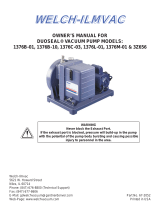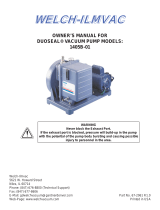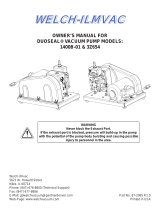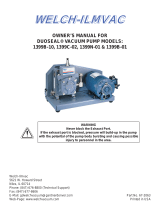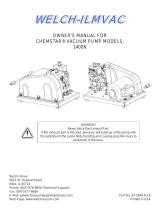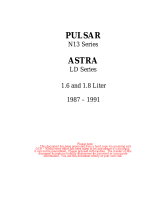Page is loading ...

OWNER’S MANUAL
FOR
WOB•L® PISTON PRESSURE/VACUUM PUMP
MODELS:
2522, 2534
WELCH-ILMVAC
Part No. 642230R 10/08
Printed in USA
Welch-Ilmvac
5621 W. Howard Street
Niles, IL 60714
Phone: (847) 676-8800 (Technical Support)
Fax: (847) 677-8606
E-Mail: gdwelchvacuum@gardnerdenver.com
Web-Page: www.welchvacuum.com
WARNING
Not recommended for pumping acid, base or organic vapors or
gases.
WARNING
Be sure to properly identify intake and discharge before using the
pump. See Section 2.50
For outside of U.S. and Canada, contact your local
Gardner Denver sales offi ce, see back page

INSTRUCTION
WARNING AND CAUTION
PLEASE READ BEFORE OPERATION
While reading your manual, please pay close attention to areas labeled:
WARNING AND CAUTION.
The description of each is found below.
WARNING
Warnings are given where failure to observe instruction could result in
injury or death to people.
CAUTION
Cautions are found where failure to observe the instruction could result
in damage to the equipment, associated equipment and process.
These units confi rm to the SI International system of units of measurement.
The following symbols (with recommendation of IEC1010) of warning will be found on the pump.
Caution - Refer to accompanying documents
Caution - Risk of electrical shock
Caution - Hot surface
WARNING
Motor includes a self resetting thermal cutout and the pump could restart
without actuation under fault condition.
2

TABLE OF CONTENTS
Section 01 - Safety Information
1.10 Warning to prevent injury
1.20 Warning to reduce risk of electrical shock
1.30 Warning to reduce risk of electrocution
1.40 Warning to reduce risk of explosion
Section 02 - Installation
2.10 Introduction
2.20 Unpacking
2.30 Pump mounting
2.40 Pump location
2.50 Intake and discharge provisions
2.60 Electrical power
2.70 Vacuum connections
2.80 Vacuum and pressure gauges
2.90 Traps
Section 03 - Operation
3.10 Starting procedures
3.20 Leak detection
3.30 Pressure range
3.40 Shutdown procedures
Section 04 - Maintenance
Section 05 - Troubleshooting
Section 06 - Specifi cations
Section 07 - Warranty
Section 08 - Exploded views and parts list
8.10 Exploded view and parts list for Model 2522
8.20 Exploded view and parts list for Model 2534
3

4
Section 1: SAFETY INFORMATION
1.10 WARNING: TO PREVENT INJURY...
1.11 Never operate this product if it has a damaged cord or plug. If it is not working properly, has
been dropped, damaged or has fallen into water, please return the product to a Welch service
center for examination and repair.
1.12 Keep the cord away from heated surfaces. All electrical products generate heat. To avoid
serious burns never touch unit during or immediately after operation.
1.13 Never block any air openings or place it on a soft surface where the openings may be blocked.
The air openings are for ventilation of the motor inside the housing. Keep all air openings free of
lint, dirt and other foreign objects.
1.14 Never drop or insert fi ngers or any other object into any openings.
1.15 Do not operate this product where oxygen is being administered.
1.16 This pump is thermally protected and can automatically restart when the protector resets.
Always disconnect power source before servicing.
1.17 Wear safety glasses and goggles when operating this product. Never point any air nozzle or air
sprayer toward another person or any part of the body.
1.18 Use only in well ventilated areas. The motor on all pumps are totally enclosed fan cooled
1.19 Do not use any tools or attachments without fi rst determining maximum air pressure for that
tool or attachment. Be sure to properly identify intake and discharge before using pump. See
Section 2.50
1.20 WARNING: TO REDUCE RISK OF ELECTRICAL SHOCK…
1.21 Do not disassemble. Disassembly or attempted repairs if accomplished incorrectly can create
electrical shock hazard. Refer servicing to qualifi ed service agencies only.
1.22 Unit is supplied with a three pronged plug. Be sure to connect pump to a properly grounded
outlet only.
1.30 WARNING: TO REDUCE RISK OF ELECTROCUTION…
1.31 Do not use this product in or near area where it can fall or be pulled into water or other liquids.
1.32 Do not reach for this product if it has fallen into liquid.
1.33 Never operate this product outdoors in the rain or in a wet area.
1.40 WARNING: TO REDUCE RISK OF EXPLOSION OR FIRE…
1.41 Do not use this pump in or near explosive atmospheres or where aerosol (spray) products are
being used.
1.42 Do not pump anything other than atmospheric air.
1.43 Do not pump combustible liquids or vapors with this product or use in or near an area where
fl ammable or explosive liquids or vapors may exist.
1.44 Do not use this product near fl ames.
WARNING
Failure to observe the above safety precautions could result in severe
bodily injury, including death in extreme cases.

5
Section 2: INSTALLATION
2.10 INTRODUCTION
2.11 This manual has been compiled not only for the care and maintenance of the Welch Dry Dual
Funktion Pressure/Vacuum Pump now in your possession, but as a helpful reference and guide
to prevent many problems which occur if used improperly
2.20 UNPACKING
2.21 Carefully remove the Pressure/Vacuum Pump from the shipping case and unfasten and remove
the wooden skid. Preserve all paperwork for future reference. If damage has occurred from
shipment, a claim must be fi led with the carrier immediately; preserve the shipping carton for
inspection by the carrier. If you are required to communicate with your dealer or Welch Vacuum
Technology, be sure to include your order numbers for quick identifi cation. Do not return the
pump to the factory without fi rst calling for a return goods number.
2.30 PUMP MOUNTING
2.31 Rubber feet are attached to the pump. Rubber feet are excellent for applications involving a
semi-fl exible surface such as a bench top; they help to isolate noise and eliminate creeping. All
Pressure/Vacuum Pumps should be mounted on a horizontal plane.
2.40 PUMP LOCATION
2.41 The Pressure/Vacuum Pump should be located preferably in a clean, dry, and well ventilated
area. Please be sure not to block the ventilation holes located on the motor housing. The pump
should be placed where the surrounding temperature remains between 10°C and 40°C (50°F
and 104°F). Always check to insure the location chosen is protected from direct or indirect
moisture contact. Welch recommends that the pump be installed at the highest point within the
system to prevent possible water condensate from entering the pump. The pump should be
located as closely to its system in order to utilize it most effi ciently.
WARNING
The motor is thermally protected and will automatically restart
unexpectedly when the overload device resets. Don’t pump fl ammable
or explosive gases or vapors or operate this pump in an atmosphere
containing fl ammable or explosive gases or vapors.

6
2.50 INTAKE AND DISCHARGE PROVISIONS
2.51 The Two regulators and two gauges make it easy to meet your vacuum and pressure
requirements. The vacuum regulator and vacuum dial gauge is attached to the intake port. The
vacuum regulator allows the vacuum level to be set between roughly atmospheric pressure
and the maximum vacuum allowed for the pump model. A moisture trap keeps water from
accidentally being drawn into the unit. The pressure regulator and pressure dial gauges are
attached to the discharge port. The pressure regulator allows discharge pressure to be set
between atmospheric and the maximum possible for the pump model. Discharge air is fi ltered
and noise is muffl ed with a fi lter.
PROPERLY IDENTIFY THE INTAKE AND DISCHARGE OF THE PUMP
Intake Discharge
Pressure/Vacuum Pump
Be sure to call Welch technical service prior to start-up at (847) 676-8800 if you have any
questions.
2.60 ELECTRICAL POWER
2.61 Power Source Review
Review the power source and the motor rating to be sure they agree in voltage, phase, and
frequency. Serious damage may occur to the motor if it is connected to an improper voltage. All
Welch pumps must be grounded. Grounding reduces the risk of electric shock in the event of an
electrical short circuit. The plug must be plugged into a properly grounded outlet.
Consult your local electrical codes if you have doubts.
2.62 Overload Protection
Motor thermal overload protection is made available by the motor manufacturer as an aid to
minimize motor failure. Overload protection is a standard feature on both 50 and 60 Hz single-
phase-motors. The motors have automatic overload protection. Automatic reset protection is
designed to reset itself after a predetermined cooling period. If the fault to the drive remains
unaltered, the motor will cycle on and off until the fault is corrected.
2.70 VACUUM CONNECTIONS
2.71 All pressure/vacuum pumps come with intake and discharge hose barbs which accept 1/4” ID
rubber pressure/vacuum hose. Hose clamps should be used to hold the hose in place. Since all
three models operate in the viscous fl ow regime, the small diameter of the hose will generate
minimal conductance loss. For best results, Welch recommends the length of the tubing between
the pump and the chamber be kept as small as possible.

7
2.80 VACUUM AND PRESSURE GAUGES
2.81 All models of pressure/vacuum pumps come with dial gauges mounted on the regulator
assemblies. The vacuum gauge gives negative pressure that is pressure below atmospheric.
The reference point for the vacuum gauge is atmospheric pressure. The pressure gauge
gives pressure above atmospheric. The reference point for the pressure gauge is atmospheric
pressure. Please keep in mind that atmospheric pressure tends to vary from day to day. As a
result of this variability, the dial vacuum gauge will indicate slightly different maximum vacuum
readings from day to day.
2.90 TRAPS
2.91 The need for a Trap
The pumps will handle humid air. All wetted aluminum parts are treated for corrosion protection
from moisture. All other wetted parts are stainless steel. A plastic trap with a ball check valve
is attached to the regulator assembly to prevent water condensate from accidentally being
ingested into the pump. If there is a chance liquid may be drawn from the process under
evacuation, Welch recommends a liquid trap be placed between the process and the pump. A
simple liquid trap is a fi ltering fl ask. See fi gure below.
When a heavy load of water vapor is evolved from the vacuum process, a cold trap is
recommended to help prevent damage to the pump mechanism. The cold trap, immersed in a
suitable Dewar fl ask, is installed so that the water vapors may come in contact with the surfaces
of the trap and condense. Commonly used refrigerants are liquid nitrogen or dry ice and acetone
or alcohol. Dry ice provides suffi cient cooling to freeze out most heavy water vapor loads. A
variety of cold traps are available from Welch. Please call our customer service department for
additional information at (847) 676-8800.
WARNING
The pump is not recommended for pumping acid, base or organic vapors
or gases. Serious damage to the pump will shorten the pump’s service life.
In addition, pumping fl ammable vapors or gases can lead to serious safety
hazard leading to fi re or explosion.
2.92 The Care of a Trap
When using a cold trap the refrigerant should be maintained at a high level in the fl ask to keep
the trap at a uniformly low temperature. If the trap is rewarmed it may allow re-evaporation of
the condensate. The refrigerant add tube on the liquid nitrogen trap should not be obstructed as
the refrigerant boil off can produce dangerously high pressures. If the trap becomes saturated
it should be disconnected from the system, drained, and cleaned. An increase in pressure in
the vacuum system will normally indicate that the trap has become saturated. To clean the trap,
remove the trap from the system and allow the trap to warm up and rinse off the condensate with
a suitable solvent in a fume hood. Thoroughly clean and dry the trap before reinstalling into the
system.

Section 3: OPERATION
3.10 STARTING PROCEDURES
3.11 Starting A Welch Pressure/Vacuum Pump
Before attaching the pump to a system, familiarize yourself with the function and action of the
pressure/vacuum pump that you have acquired. Review the power requirements as described in
Section 2.60. Welch recommends running the pump for a few minutes to warm it up, before use.
The warm-up improves the pumps ability to handle humid air.
3.12 Cleanliness
Take every precaution to prevent foreign particulates from entering the pump. Particulates
will damage the pump’s performance. If you fi nd that particulates come off the process during
evacuation, a particulate trap in the foreline will work. A simple, inexpensive trap may be made
by placing glass wool in a glass or plastic tube. Screens must be inserted to hold the glass wool
in place.
3.20 LEAK DETECTION
The importance of eliminating all leaks in a vacuum system is obvious. The pump must remove
this added volume of leaked gas to maintain the desired vacuum. Leaks for these pump can
be located by slightly pressuring the system and painting the suspected area with a thick soap
solution. Escaping air will produce soap bubbles.
3.30 PRESSURE RANGE
Pressure/Vacuum pumps are designed to be run from slightly below atmospheric to their
maximum vacuum level on the intake side. The pumps also may be run from atmospheric
to their maximum rated pressure rating. Consult the Specifi cation Table (See Section 6,
Specifi cations) for the ratings of your specifi c model.
3.40 SHUTDOWN PROCEDURES
After use, Welch recommends the pump be run for about 2 minutes disconnected from the
vacuum process. The air pumped through the mechanism will purge out water vapor or droplets
of water condensate that may have formed on the inside of the pump. This purge of the pump
mechanism helps prevent corrosion.
Section 4: MAINTENANCE
4.10 GENERAL MAINTENANCE
Welch dry pressure/vacuum units are 100% oil free. The pump employs a non-lube piston and
cylinder. No maintenance is necessary for the bearings. All bearings are sealed and permanently
lubricated. Lubrication should not be attempted. The units are built for continuous duty operation
with the quietness and durability of a diaphragm, but with piston performance.
8

Section 5: TROUBLESHOOTING
5.10 TROUBLESHOOTING TABLE
Poor
Pumping
Speed
Poor
Vacuum Loud
Unit Possible Cause Corrective Action
X X X Damaged valves Replace fl apper valves
X X X Debris in valves Remove debris and check for valve damage
X X X Damaged gasket Replace gasket
X X X Loose head screw Tighten head screw
X X X Loose fi tting Tighten fi tting
Section 6: SPECIFICATION
6.10 SPECIFICATION CHART
Welch Model 2522 2534
Free Air Displacement
CFM (L/min.) @60Hz 0.76 (22) 1.20 (34)
M3 (L/min.) @50Hz 0.66 (19) 1.0 (28)
Maximum Continuous Pressure
PSIG (Pascal) 100 50
Maximum Vacuum
In.Hg. (Torr) 25.6 (110) 26.2 (950
Motor Horsepower
Horsepower 1/8 1/7
Tubing needed
I.D. in Inches 1/4 1/4
Weight lbs 11.7 11.7
(Kg.) (5.3) (5.3)
Catalog Number
Wired for 115V, 60Hz,1Phwith North American 115V Plug 2522B-01 2534B-01
Wired for 220V, 50Hz, 1Ph with European (Schuko) Plug 2522C-02 -
Wired for 230V, 60Hz, 1Ph with Cont. Euro 230V Plug 2522C-10 -
NOTE: *230V 60Hz Models have a maximum continuous pressure of 50PSIG (5x105 Pascal)
**50Hz models are provided with CE agency mark.
9

Section 7: WARRANTY
UNPACKING
Inspect the pump carefully. If any damage has occurred, fi le claim with the carrier immediately.
Save the shipping container for carrier to inspect.
OPERATING PUMP
Refer to the enclosed Instruction/Operation Manual for all information to properly operate and
maintain the pump.
WARRANTY
This Welch Vacuum product is warranted to be free from defects in material and workmanship.
The liability of Gardner Denver Welch Vacuum Technology, Inc. under this warranty is limited
to servicing, adjusting, repairing or replacing any unit or component part which in the judgment
of Gardner Denver Welch Vacuum Technology, Inc. has not been misused, abused or altered
in any way causing impaired performance or rendering it inoperative. No other warranties are
expressed or implied. The method of executing this warranty: servicing, adjusting, repairing or
replacing shall be at the discretion of Gardner Denver Welch Vacuum Technology, Inc. Vacuum
pumps that have been used for any period, however short, will be repaired under this warranty
rather than replaced.
The warranty is effective for one year from the date of original purchase when:
1. The warranty card has been completed and returned.
2. The product is returned to the factory or other designated service centers, freight prepaid.
3. The product in our judgment is defective through no action or fault of the user.
If the product has become defective through misuse, abuse, or alteration, repairs will be billed
regardless of the age of the product. In this event, an estimate of the repair costs will be
submitted and authorization of these charges will be required before the product is repaired and
returned.
To reduce additional charges and delays either within or outside of the warranty period, contact
Gardner Denver Welch Vacuum Technology, Inc. @ 847-676-8800 for a return authorization
number. Products without a return authorization number will be refused by our receiving
department. Before shipping, properly pack the pump, insure it against loss or damage, and on
the outside of the pump packaging and the packing slip write in the return authorization number.
Pumps damaged due to improper packaging are the customer’s responsibility.
10

11
Note 1: These parts are not available separately, but are supplied in service kits.
Item Qty. Part No. Description Service Kit
2522K-03 Seal Kit
2522K-04 Foot Kit
2500K-04
1 1 2522K-01 Connecting Rod Ass’y 1 - -
2 1 Note 1 Screw, Handle 2 - -
3 1 Note 1 Screw, Head 4 - -
4 1 Note 1 O-ring, Head 1 1 -
5 1 2522K-02 Valve Plate Ass’y 1 - -
6 1 Note 1 O-ring, Cylinder 1 1 -
7A 1 Note 1 Jar - Plastic 1 1 -
7B 1 Note 1 Jar - Plastic 1 1 -
8 1 Note 1 Filter Element 1 1 -
10 1 Note 1 Ball 1 1 -
12 1 Note 1 Gasket 2 2 -
13 1 Note 1 Rubber Suction Feet - - 4
Section 8: PARTS LIST AND EXPLODED VIEW
8.10 Model 2522B-01, 2522C-02
Model 2522B-01 (115V 60Hz)
Item Qty. Part No. Description
9 1 726025 Pressure Gauge
11 1 726021 Vacuum Gauge
14 1 2522K-06 Pressure Regulator Ass’y
15 1 2522K-05 Vacuum Regulator Ass’y
Model 2522C-02 (230V 50Hz)
Item Qty. Part No. Description
9 1 726026 Pressure Gauge
11 1 726024 Vacuum Gauge
14 1 2522K-06 Pressure Regulator Ass’y
15 1 2522K-05 Vacuum Regulator Ass’y

12
Note 1: These parts are not available separately, but are supplied in service kits.
Section 8: PARTS LIST AND EXPLODED VIEW
8.20 Model 2534B-01
Item Qty. Part No. Description Service Kit
2534K-03 Seal Kit
2522K-04 Foot Kit
2500K-04
1 1 2534K-01 Connecting Rod Ass’y 1 - -
2 1 Note 1 Screw, Handle 2 - -
3 1 Note 1 Screw, Head 4 - -
4 1 Note 1 O-ring, Head 1 1 -
5 1 2565K-02 Valve Plate Ass’y 1 - -
6 1 Note 1 O-ring, Cylinder 1 1 -
7A 1 Note 1 Jar - Plastic 1 1 -
7B 1 Note 1 Jar - Plastic 1 1 -
8 1 Note 1 Filter Element 1 1 -
9 1 Note 1 Ball 1 1 -
12 1 Note 1 Gasket 2 2 -
13 1 Note 1 Rubber Suction Feet - - 4
16 1 Note 1 Replacement Filters 3 3 -
17 1 Note 1 O-ring, Cylinder 1 1 -
Model 2534B-01 (115V 60Hz)
Item Qty. Part No. Description
9 1 726025 Pressure Gauge
11 1 726021 Vacuum Gauge
14 1 2522K-06 Pressure Regulator Ass’y
15 1 2522K-05 Vacuum Regulator Ass’y

WELCH-ILMVAC
Vacuum Pump Repair Facility
5621 W. Howard Street
Niles, IL 60714
Phone: (847) 676-8800 (Technical Support)
Fax: (847) 677-8606
E-Mail: gdwelchvacuum@gardnerdenver.com
Web-Page: www.welchvacuum.com
This document contains confi dential and trade secret information which is the property of Welch
Vacuum Technology and receipt or possession does not convey any rights to loan, sell, or otherwise
disclose said information, reproduction or use of said information for any purpose other than that in
connection with said information was supplied may not be made without express written permission of
Welch. This document is to be returned to Welch upon request and in all events upon completion of
the purpose for which it is loaned.
Copyright© 2008 Gardner Denver Thomas, Inc.
Welch Vacuum Technology
Welch is a registered trademark of Gardner Denver Thomas, Inc.
/

